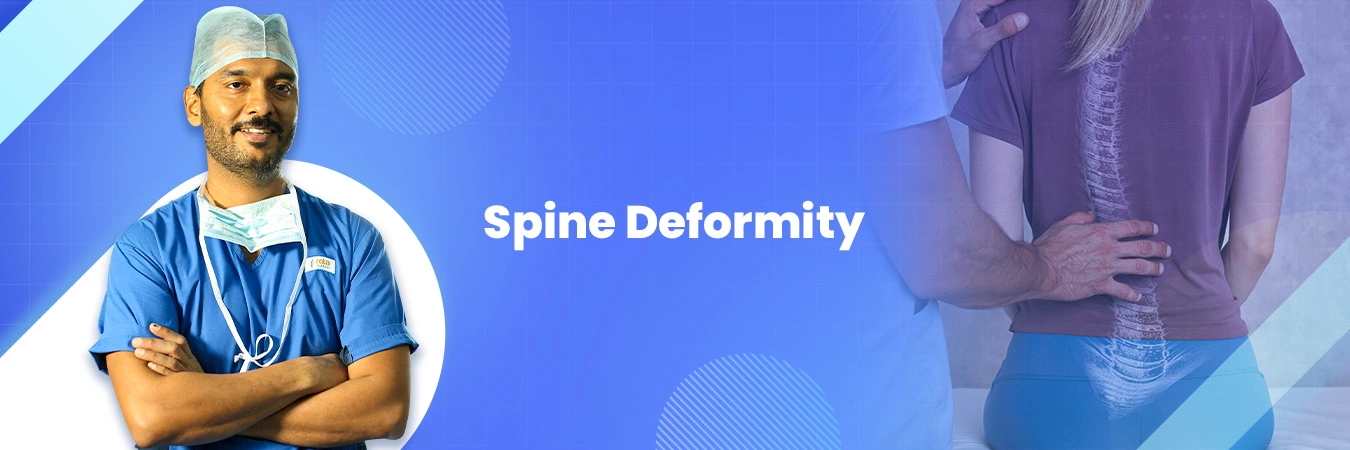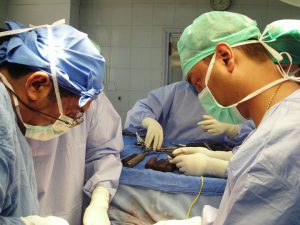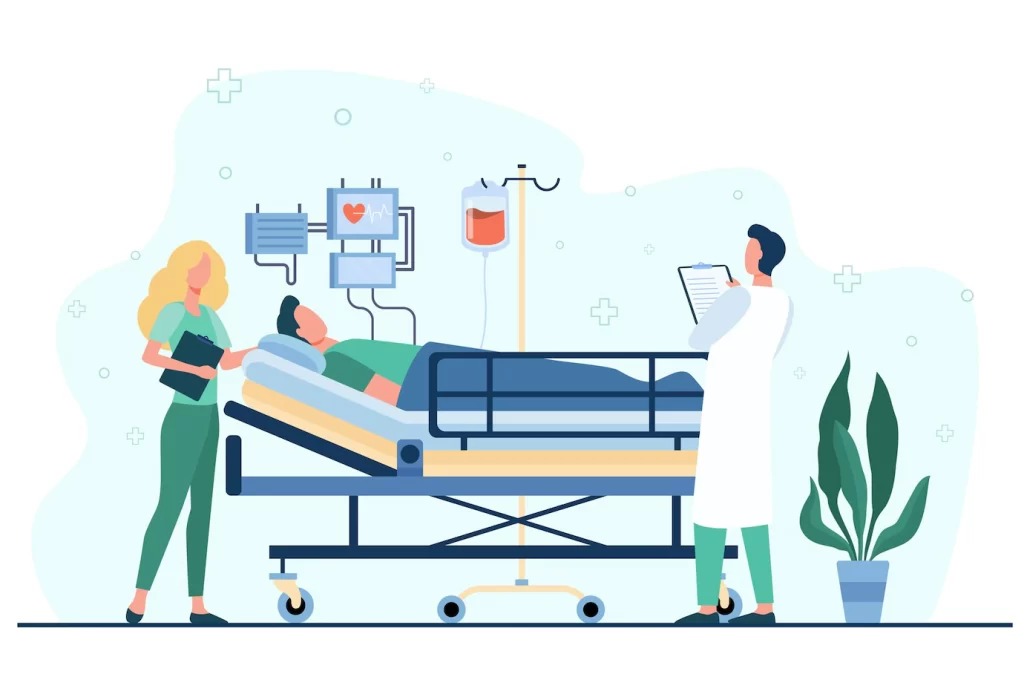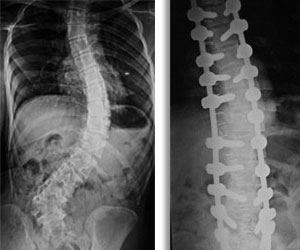
A spine deformity refers to an abnormal alignment or curvature of the bony spine. It can lead to conditions like adult scoliosis and kyphosis, often caused by age-related wear and tear or complications from prior surgeries. These deformities result from the deterioration of facet joints and discs over time, impacting the spine’s normal posture and causing pain due to joint or nerve compression.
At Total Spine – Dr. Parthasarathy Srinivasan, we specialise in the comprehensive treatment of spine deformities in Chennai. Our expert team addresses conditions such as scoliosis, kyphosis, and lordosis with advanced surgical techniques and personalised care.

Our approach focuses on restoring spinal alignment and relieving pain through tailored treatment plans. Dr. Parthasarathy Srinivasan and his team of top spinal deformity correction specialists in Chennai are dedicated to delivering effective solutions that improve patients’ quality of life.
Kyphosis refers to a condition where the upper back becomes excessively curved forward, often resulting in noticeable bumps or deformities. This condition can vary in severity and may lead to discomfort or limited mobility. At Total Spine – Dr. Parthasarathy Srinivasan in Chennai, we specialise in comprehensive spine care, offering advanced treatments tailored to correct spinal deformities effectively.
Our focus is on providing specialised care for spine deformities, ensuring optimal outcomes through personalised treatment plans. Led by Dr. Parthasarathy Srinivasan, a renowned spine surgeon in Chennai, our team is dedicated to utilising cutting-edge techniques and advanced surgical procedures to address kyphosis and other spinal conditions.
Lordosis commonly known as swayback, at Total Spine in Chennai. Led by Dr. Parthasarathy Srinivasan, a renowned expert in spine surgery, our clinic offers specialised care that restores spinal alignment and enhances mobility.
Spinal deformities such as lordosis can significantly impact daily life, affecting posture and causing discomfort. At Total Spine, we specialise in comprehensive treatment options tailored to each patient’s needs. Whether you’re seeking the best spine deformity treatment in Chennai or expert spinal deformity correction surgery, Dr. Parthasarathy Srinivasan and our dedicated team provide personalised care with a focus on your well-being.
Scoliosis is a frontal spinal deformity where the spine curves sideways when viewed from the front. Typically, this curvature stabilises once skeletal growth completes, but in adulthood, it may progress due to disc degeneration. For effective treatment of spine deformities in Chennai, consult Dr. Parthasarathy Srinivasan at Total Spine. As a leading specialist in spinal deformity correction, Dr. Srinivasan offers the best treatments tailored to each patient’s needs. His expertise ensures comprehensive care and effective solutions for spinal deformities, making him a trusted choice for deformity spine surgery in Chennai. Discover top-quality care and advanced treatments at Total Spine to correct spinal deformities and improve your quality of life.
Symptoms of spinal issues may manifest visibly or be felt by others. Signs of scoliosis include uneven shoulder and hip heights, asymmetrical arm positioning, a visibly off-centre spine, and a head that appears misaligned. Imbalance signs encompass a slouched posture, a hunched back, and difficulty maintaining an upright stance.
Individuals with these conditions may experience varying symptoms. For instance, most cases of scoliosis in infants, adolescents, and adults are asymptomatic. Conversely, degenerative scoliosis often presents with pain. Sagittal imbalance can lead to significant discomfort in addition to mild pain. Spinal deformities can also impact the spinal cord or nerve roots, potentially causing pain, weakness, numbness, and tingling sensations that radiate to the arms and legs.
For individuals seeking spine surgery in Chennai, Dr. Parthasarathy Srinivasan at Total Spine specialises in comprehensive treatment options. As a leading spine deformity surgeon in Chennai, Dr. Srinivasan offers advanced solutions for spine deformity treatment. His expertise ensures precise spinal deformity correction tailored to each patient’s needs, utilising cutting-edge techniques to restore spinal alignment and alleviate symptoms effectively.

At Total Spine, we prioritise effective spine deformity treatment in Chennai, offering specialised care under the expertise of Dr. Parthasarathy Srinivasan. We understand the importance of non-surgical approaches before considering surgical options, ensuring personalised care tailored to each patient’s needs.

Before surgical intervention, we emphasise non-invasive treatments including pain management strategies, customised physical therapy incorporating gait and postural training, and the use of specialised braces. These approaches are designed to alleviate discomfort and enhance mobility, promoting optimal spinal health.
For cases requiring surgical correction, Dr. Parthasarathy Srinivasan, renowned for spine deformity surgery in Chennai, provides advanced solutions. With a focus on precision and patient-centred care, our team employs cutting-edge techniques to address spinal deformities effectively.
Our commitment to excellence extends to every aspect of patient care, from diagnosis to recovery. We strive to optimise outcomes and improve quality of life through compassionate treatment and surgical expertise.

Spinal surgery becomes necessary under specific conditions. It is recommended when the spinal curvature begins to compress organs causing symptoms, when the curvature worsens progressively, or when severe pain persists despite medical and conservative treatments. In spine surgery, precise instrument placement and spinal mobilisation are crucial for correcting the curvature. This procedure often includes spinal fusion, which stabilises the spine in its corrected position, preventing further curvature progression.
Neurosurgeons utilise screws, rods, and bone grafts (harvested from elsewhere in the body) to facilitate the growth of new bone in the correct alignment. This approach aims to alleviate symptoms and restore spinal function effectively.
For those seeking specialised care in Chennai, Total Spine – Dr. Parthasarathy Srinivasan offers comprehensive treatment for spinal deformities. Our expert team provides advanced solutions tailored to each patient’s needs, ensuring optimal outcomes in spine deformity treatment. We are dedicated to delivering superior care through precise surgical interventions and personalised patient management.
If you are searching for the best spine deformity treatment in Chennai, trust Total Spine – Dr. Parthasarathy Srinivasan for expert care. Contact us today to schedule a consultation with one of Chennai’s top spinal deformity correction specialists.
Dr. Parthasarathy Srinivasan was one of eight candidates selected from many aspirants from all the member countries of the Asia-Pacific Orthopaedic Association (APOA) for the prestigious APOA Depuy Spine travelling fellowship – Oct 2009.
